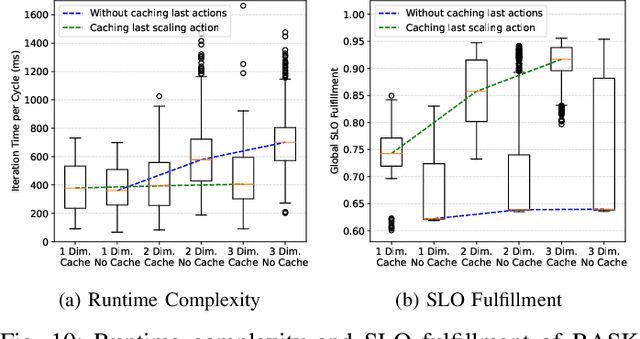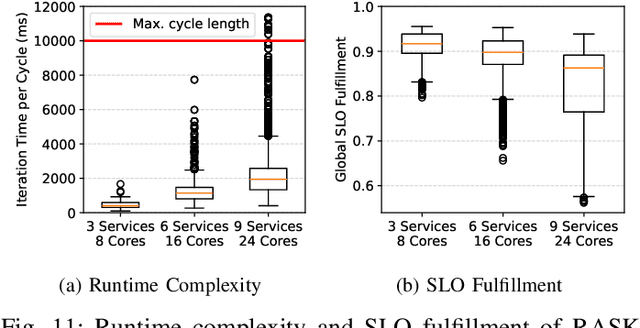Andrea Morichetta
Multi-Dimensional Autoscaling of Stream Processing Services on Edge Devices
Oct 08, 2025



Abstract:Edge devices have limited resources, which inevitably leads to situations where stream processing services cannot satisfy their needs. While existing autoscaling mechanisms focus entirely on resource scaling, Edge devices require alternative ways to sustain the Service Level Objectives (SLOs) of competing services. To address these issues, we introduce a Multi-dimensional Autoscaling Platform (MUDAP) that supports fine-grained vertical scaling across both service- and resource-level dimensions. MUDAP supports service-specific scaling tailored to available parameters, e.g., scale data quality or model size for a particular service. To optimize the execution across services, we present a scaling agent based on Regression Analysis of Structural Knowledge (RASK). The RASK agent efficiently explores the solution space and learns a continuous regression model of the processing environment for inferring optimal scaling actions. We compared our approach with two autoscalers, the Kubernetes VPA and a reinforcement learning agent, for scaling up to 9 services on a single Edge device. Our results showed that RASK can infer an accurate regression model in merely 20 iterations (i.e., observe 200s of processing). By increasingly adding elasticity dimensions, RASK sustained the highest request load with 28% less SLO violations, compared to baselines.
Adaptive Stream Processing on Edge Devices through Active Inference
Sep 26, 2024Abstract:The current scenario of IoT is witnessing a constant increase on the volume of data, which is generated in constant stream, calling for novel architectural and logical solutions for processing it. Moving the data handling towards the edge of the computing spectrum guarantees better distribution of load and, in principle, lower latency and better privacy. However, managing such a structure is complex, especially when requirements, also referred to Service Level Objectives (SLOs), specified by applications' owners and infrastructure managers need to be ensured. Despite the rich number of proposals of Machine Learning (ML) based management solutions, researchers and practitioners yet struggle to guarantee long-term prediction and control, and accurate troubleshooting. Therefore, we present a novel ML paradigm based on Active Inference (AIF) -- a concept from neuroscience that describes how the brain constantly predicts and evaluates sensory information to decrease long-term surprise. We implement it and evaluate it in a heterogeneous real stream processing use case, where an AIF-based agent continuously optimizes the fulfillment of three SLOs for three autonomous driving services running on multiple devices. The agent used causal knowledge to gradually develop an understanding of how its actions are related to requirements fulfillment, and which configurations to favor. Through this approach, our agent requires up to thirty iterations to converge to the optimal solution, showing the capability of offering accurate results in a short amount of time. Furthermore, thanks to AIF and its causal structures, our method guarantees full transparency on the decision making, making the interpretation of the results and the troubleshooting effortless.
Learning-driven Zero Trust in Distributed Computing Continuum Systems
Nov 29, 2023



Abstract:Converging Zero Trust (ZT) with learning techniques can solve various operational and security challenges in Distributed Computing Continuum Systems (DCCS). Implementing centralized ZT architecture is seen as unsuitable for the computing continuum (e.g., computing entities with limited connectivity and visibility, etc.). At the same time, implementing decentralized ZT in the computing continuum requires understanding infrastructure limitations and novel approaches to enhance resource access management decisions. To overcome such challenges, we present a novel learning-driven ZT conceptual architecture designed for DCCS. We aim to enhance ZT architecture service quality by incorporating lightweight learning strategies such as Representation Learning (ReL) and distributing ZT components across the computing continuum. The ReL helps to improve the decision-making process by predicting threats or untrusted requests. Through an illustrative example, we show how the learning process detects and blocks the requests, enhances resource access control, and reduces network and computation overheads. Lastly, we discuss the conceptual architecture, processes, and provide a research agenda.
Distributed AI in Zero-touch Provisioning for Edge Networks: Challenges and Research Directions
Nov 29, 2023Abstract:Zero-touch network is anticipated to inaugurate the generation of intelligent and highly flexible resource provisioning strategies where multiple service providers collaboratively offer computation and storage resources. This transformation presents substantial challenges to network administration and service providers regarding sustainability and scalability. This article combines Distributed Artificial Intelligence (DAI) with Zero-touch Provisioning (ZTP) for edge networks. This combination helps to manage network devices seamlessly and intelligently by minimizing human intervention. In addition, several advantages are also highlighted that come with incorporating Distributed AI into ZTP in the context of edge networks. Further, we draw potential research directions to foster novel studies in this field and overcome the current limitations.
EXPLAIN-IT: Towards Explainable AI for Unsupervised Network Traffic Analysis
Mar 03, 2020



Abstract:The application of unsupervised learning approaches, and in particular of clustering techniques, represents a powerful exploration means for the analysis of network measurements. Discovering underlying data characteristics, grouping similar measurements together, and identifying eventual patterns of interest are some of the applications which can be tackled through clustering. Being unsupervised, clustering does not always provide precise and clear insight into the produced output, especially when the input data structure and distribution are complex and difficult to grasp. In this paper we introduce EXPLAIN-IT, a methodology which deals with unlabeled data, creates meaningful clusters, and suggests an explanation to the clustering results for the end-user. EXPLAIN-IT relies on a novel explainable Artificial Intelligence (AI) approach, which allows to understand the reasons leading to a particular decision of a supervised learning-based model, additionally extending its application to the unsupervised learning domain. We apply EXPLAIN-IT to the problem of YouTube video quality classification under encrypted traffic scenarios, showing promising results.
 Add to Chrome
Add to Chrome Add to Firefox
Add to Firefox Add to Edge
Add to Edge